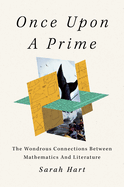
Since 2020, Sarah Hart has served as the Gresham Professor of Geometry; she's only the 33rd person--and the first woman--to hold the post since its origins in Tudor England. She's also an avid lover of books, and in Once Upon a Prime: The Wondrous Connections Between Mathematics and Literature, she sets out to show just how much her twin passions have in common. It's an affable guide to numerous mathematical concepts and to illuminating close readings, and Hart's good-natured enthusiasm for both books and numbers is sure to set even the most math-shy readers at ease. That enthusiasm is contagious. Joy abounds as she digs into the mathematical structure that undergirds Eleanor Catton's The Luminaries or the trove of geometric metaphors to be found in Moby-Dick.
Catton and Melville are but two highlights among the bevy of literary personalities and references Hart cites in her survey. Another delightful feature is Hart's affection for a cadre of mid-20th-century French theorists collectively called the Oulipo, to whom she devotes a chapter. It's easy to see why Hart is so taken with the Oulipians, whose roster featured such notable members as Italo Calvino and Marcel Duchamp; identifying mathematics "as the lodestone of structure," they used it to invent new and often highly conceptual literary forms with a spirit of playfulness and imagination. That mathematics can be such a wellspring of inspiration--and, in the case of literature, often inseparable from artistic creation itself--is a case that Hart's debut makes with undeniable warmth and exuberance. --Theo Henderson, bookseller at Ravenna Third Place Books in Seattle, Wash.

